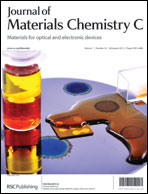Efficient monochromatic red-light-emitting PLEDs based on a series of nonconjugated Eu-polymers containing a neutral terpyridyl ligand†
Abstract
Three novel Eu-polymers containing hole transporting units and light-emitting units in the main chain have been designed and synthesized via radical copolymerization of N-vinylcarbazole and polymerizable Eu(TTA)3vinyl-tpy, where TTA is 2-thenoyltrifluoroacetonate. The chemical structure and composition of the Eu-polymers were characterized by FTIR, UV-vis, 1H NMR, 13C NMR spectroscopy, GPC, ESI-MS, and elemental analysis. The geometry of the polymerizable monomer Eu(TTA)3vinyl-tpy was predicted using the Sparkle/PM6 model and suggested to be in a chemical environment with very low symmetry around the Eu3+ ions (C1), in agreement with the fluorescence spectrum. All Eu-polymers exhibited good solubility, as well as good thermal stability and high glass transition temperatures. The photoluminescence (PL) properties of the copolymers in solution and in the solid state were investigated in detail. Intramolecular energy transfer from the carbazole groups to the europium complexes occurred even in diluted solutions. The efficiency of this process also depended on the composition of the Eu-polymers. In the solid state, emission from the carbazole groups was suppressed and the absorbed excitation energy was transferred effectively to the europium complexes in the Eu-polymers. Most importantly, the EL performances of eight pure red-emission PLEDs based on P1, P2, and P3 as the emitting layer have been studied in detail. Bright electroluminescence with a maximum luminance of 68.2 cd m−2 from the double-layer devices of P1 was demonstrated. Although the EL performance was only the third-best among those of the Eu-chelated polymers reported so far, to the best of our knowledge, this is the first example of electroluminescent devices of Eu-polymers based on tpy as a neutral ligand. These results illustrate the potential application of polymerizable tpy ligands in high performance EL Eu-chelated polymers.


 Please wait while we load your content...
Please wait while we load your content...